6 May 2025
Stressed cats in consulting rooms – prevention is better than cure
Alex Taylor RVN outlines how applying more cat-friendly approaches in practices is beneficial not just to the animals and their owners, but also veterinary teams managing them.

Image: Gioia / Adobe Stock
Providing veterinary care to cats in a busy clinic environment can be challenging, but it does not have to be.
Focusing on both the physical health and mental well-being of cats not only helps veterinary professionals provide more rounded, holistic veterinary care, it also makes examinations and procedures carried out in the consulting room flow more efficiently, leading to less-stressful and safer interactions for cats and the veterinary team (Ryan, 2018).
The key to providing effective and welfare-focused veterinary care to cats is not to rush, but to prepare the environment so it is optimised for cats, and then work slowly and methodically with team members, adapting how they interact with cats in the consult room according to their species-specific needs and each animal’s individual needs (Rodan et al, 2022).
Additional consideration should be given to cats affected by disease, injury and/or distress. Such challenges will likely be reflected in their emotional state and subsequent behaviours in the consult room (Horwitz and Rodan, 2018).
Furthermore, applying a more cat-friendly approach during the veterinary clinic is not just beneficial for cats and caregivers, but it has also been shown to improve job satisfaction in the veterinary team (Rodan et al, 2022).
Stressors
Stressors trigger distress, and can be defined as “events, experiences, sensations or stimuli that have the potential to be perceived negatively” (Mills, 2016). Unfortunately, most cats are exposed to several stressors before they enter the veterinary consulting room and are, therefore, already in a protective emotional state before any interactions with the veterinary team occur.
This process, known as “stressor stacking”, means that cats may be distressed at the veterinary clinic, making them more likely to avoid interactions by hiding, or showing repulsion behaviours, such as growling, hissing, swiping or biting. These signs are an indication the cat is emotionally uncomfortable, putting patient and staff safety at risk (Figure 1).

Anxiety, fear and frustration may all be experienced by cats prior to and during their veterinary visit. These protective emotions are present to serve a purpose: to keep cats safe from threats.
Most cats will be in a protective emotional state during this time, as exposure to some stressors is inevitable; for example, all cats will need to travel to the clinic.
However, if members of the veterinary team are aware of these stressors, they can plan accordingly, helping to reduce the intensity of any protective emotions the cat experiences, and preventing behaviours that hinder proper veterinary care.
Caregivers find travelling to the clinic and other animals in the waiting room stressful elements of the veterinary visit (Caney et al, 2022). Providing them with helpful information prior to veterinary visits not only helps cats, but also reduces the likelihood of caregivers having an unpleasant experience, meaning they are more likely to bring their cats to the clinic to receive the care they need (Taylor et al, 2022).
Tips on preventing stressor stacking in cats prior to the veterinary consultation include advice on:
- Scheduling appointments around the cat’s normal routine; for example, not at feeding times.
- Choosing the most appropriate carrier (Figure 2).
- Getting their cat used to the carrier/carrier training (Figure 3).
- How to best place their cat in the carrier (Figure 4).
- Travelling to the clinic.
- Arriving at the veterinary clinic and waiting for the appointment.
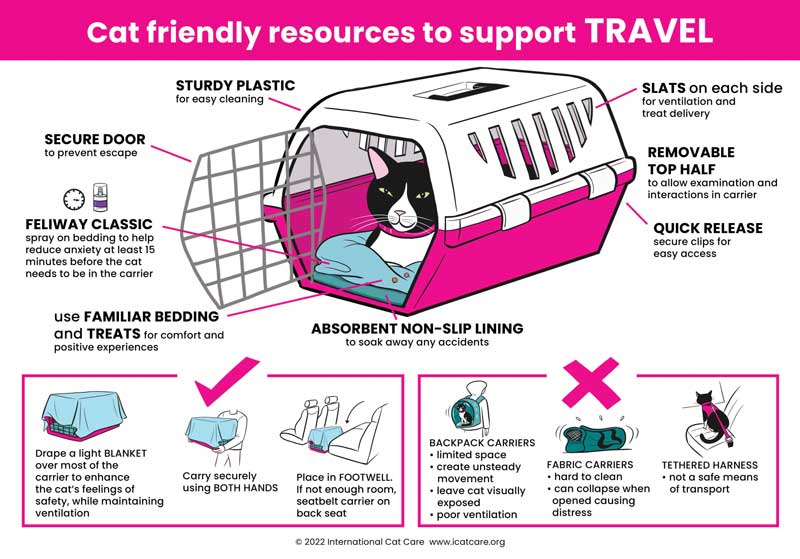


Waiting areas
The waiting area can be a significant source of stress for cats and caregivers (Caney et al, 2022). Cats are exposed to a multitude of unfamiliar sights, sounds and smells, such as bright lights, people coming in and out, barking dogs, phones ringing, strong disinfectants and even the presence of other cats.
These stressors can cause emotional distress for cats which are confined in their carrier and may feel vulnerable. Emotionally challenged cats can be highly reactive, making examinations in the consulting room difficult and at times almost impossible. This compromises patient welfare, veterinary care and puts staff at risk of injury.
Creating a separate waiting area for cats can help reduce their exposure to stressors, but it should not be assumed that this alone is enough to sufficiently minimise any stress experienced by cats and their caregivers waiting for appointments.
If separate cat waiting areas are not available, other steps can still be taken to improve patient and caregiver experience at the clinic. Simple measures can reduce exposure to stressors in the waiting room, facilitating easier examinations once cats arrive in the consulting room (Taylor et al, 2022), such as:
- Scheduling cat-only visit times.
- Using furniture or barriers to separate dogs from cats.
- Guiding dog and cat caregivers to opposite sides of the waiting area.
- Giving caregivers the option to wait in their car or in a separate consulting room.
- Offering covers for carriers and providing elevated spaces for cat carriers to be placed; for example, chairs, tables or shelves (Figures 5a, 5b and 6).
- Using synthetic pheromone therapy in the waiting area and/or on carrier covers.
- Reducing the volume of phones at the reception desk or directing incoming phone calls to a separate room in the clinic.
- Using unscented disinfectant.
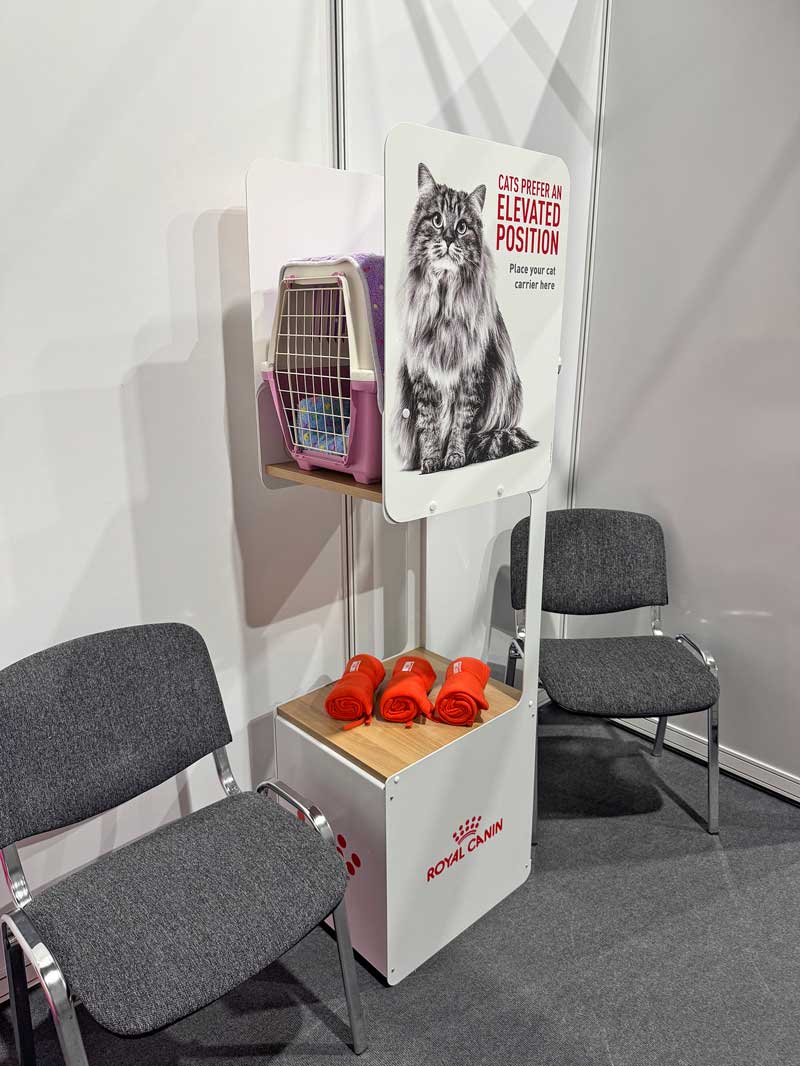
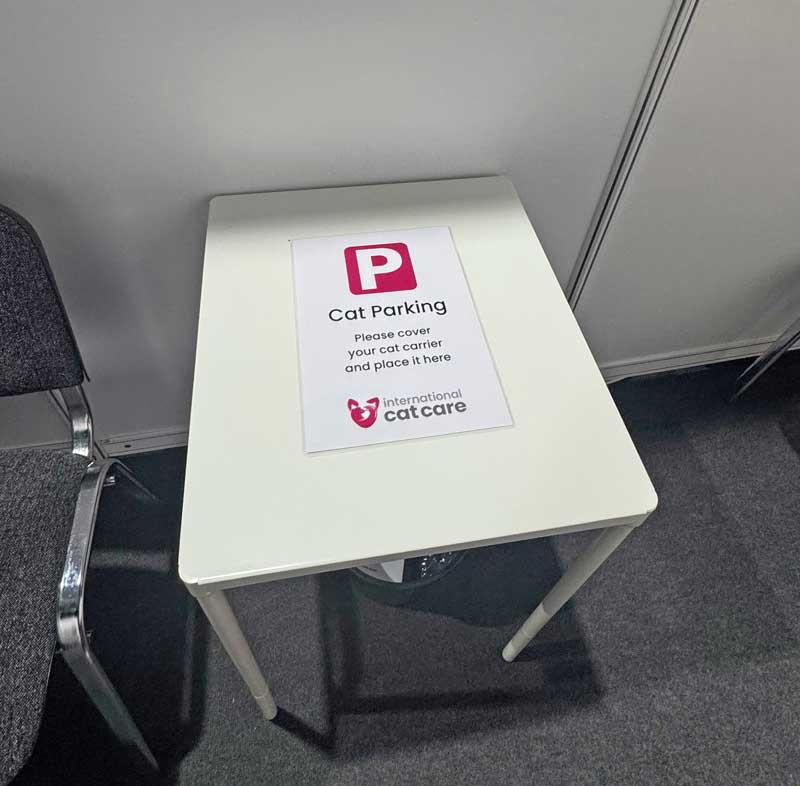
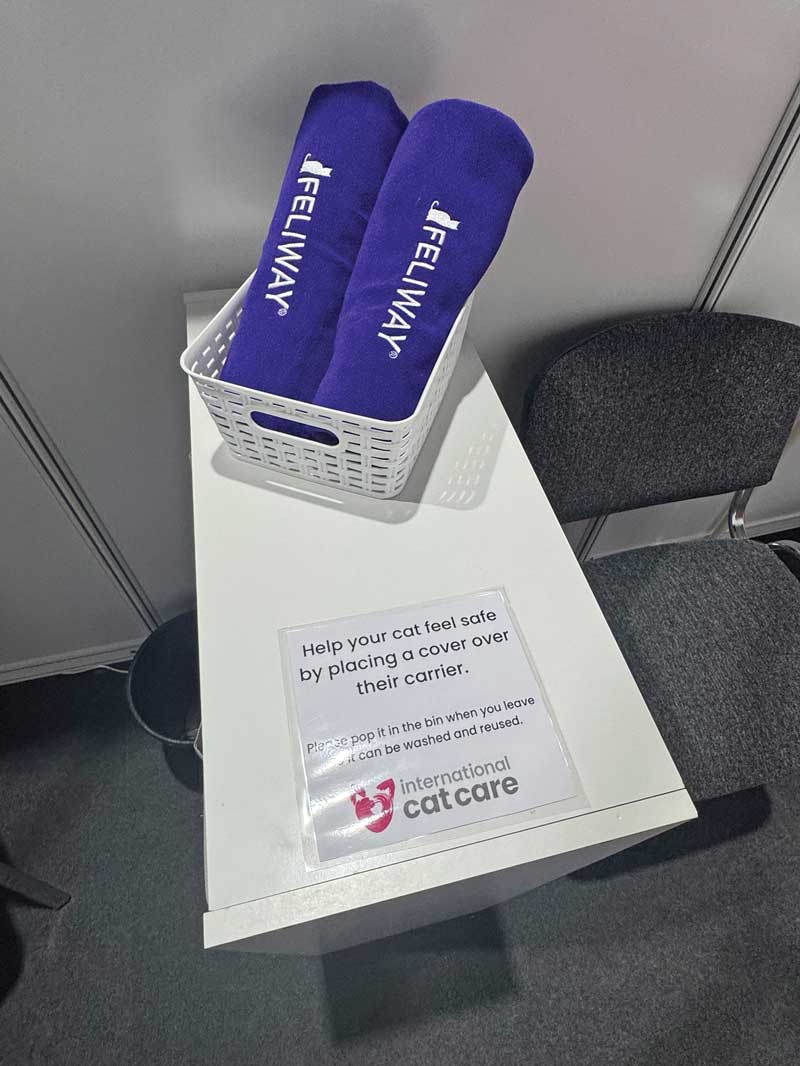
Consulting room environment
Veterinary professionals can take several steps to ensure the consulting room is cat friendly. Using specific consulting rooms for cat appointments is beneficial, minimising exposure to the smells of other animals; for example, dogs.
Preparation is key, so ensuring all necessary equipment – for example, stethoscopes, thermometers, quiet clippers, blood-taking equipment, small cat scales, blood pressure monitor and cat treats for the consultation – is ready beforehand helps prevent interruptions and helps to reduce the likelihood of cats becoming startled once they are on the examination table (Taylor et al, 2022).
Non-slip mats, towels or beds can be placed over the examination table to prevent slippage, and to ensure cats stay warm and comfortable throughout the consultation and during procedures. The towels should be changed between each patient. Using signage on doors is also an effective way of preventing people from entering the room during the consultation (Figure 7 and 8).
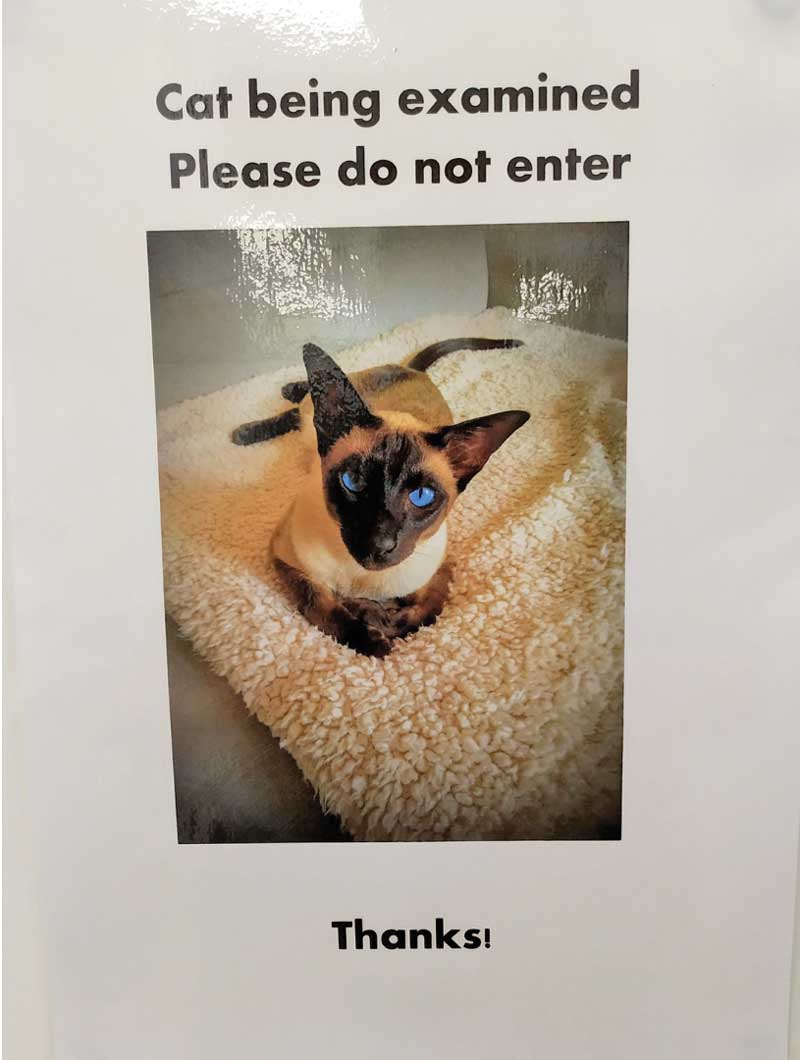
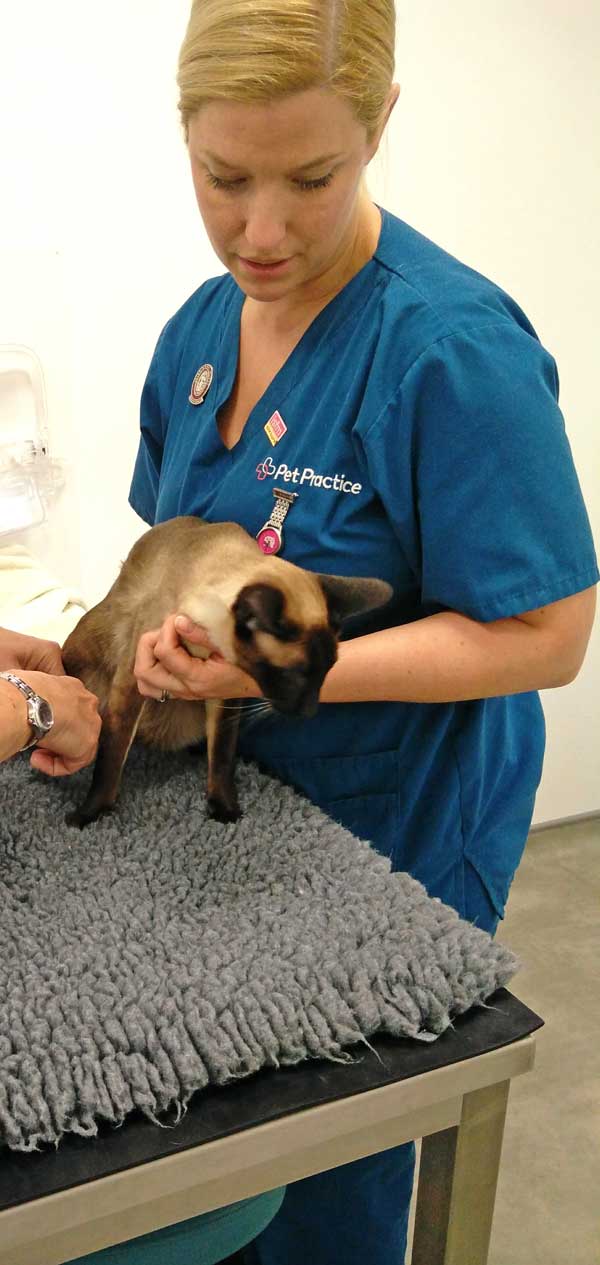
Cats have a sensitive sense of smell, so the environment needs to be managed to respect this (Ellis et al, 2013). Ensuring the consult room is thoroughly cleaned with an unscented disinfectant between patients helps optimise the area ready for use.
Specific attention should be paid to areas where cats scent mark by face rubbing, such as edges of the computer screen or corners of walls or cabinets (Taylor et al, 2022). The use of surgical spirit for taking blood samples and placing intravenous cannulas in cats is not recommended, as the smell is aversive for cats. Instead, unscented surgical scrub can be used for skin preparation (Taylor et al, 2022).
The use of synthetic feline pheromone spray on the examination table has been shown to reduce stress in cats during veterinary consultations (Pereira et al, 2015), creating a sense of security in an unfamiliar environment. Veterinary professionals may also want to consider wearing specific uniforms for cat consultations, to minimise how many different scents cats are exposed to during the consultation.
Lighting, noise and movement are factors that may influence a cat’s emotional state and behaviour during a consultation. Veterinary background noises, such as dogs barking, people talking and kennel doors shutting, have been shown to elicit fear responses in cats during examinations (Furgala et al, 2022).
Cats may also be overwhelmed or startled by very bright lights, fast movements and noises the veterinary team are accustomed to in the consulting room, such as cupboard doors or drawers closing.
Voices should be kept low in the clinic and the use of noisy clinic equipment near the consulting room (for example, centrifuges, vacuum cleaners or washing machines) is best avoided. Using light dimmers, closing drawers and cupboard doors slowly and gently, and allowing cats to hide under a towel can all minimise stress of cats in the consulting room (Figures 9 and 10).


Consulting room interactions
Cats may not want to leave their carrier voluntarily in the consulting room, and care should be taken not to forcefully extract them.
Instead, examinations can take place with cats inside their carrier with lid removed and under a towel, if required, giving them a sense of security and control during the examination process. Caregivers can be advised to purchase carriers with removable lids if they do not already have one, as this will help facilitate easier examinations for future appointments.
Some cats do not want to stay in their carrier and will also benefit from being given the freedom to explore the consulting room. Cats can be given the opportunity to do this when a history is being taken from the caregiver, giving the cat time to acclimatise to the consulting room environment (providing doors and windows are secured; Figure 11).
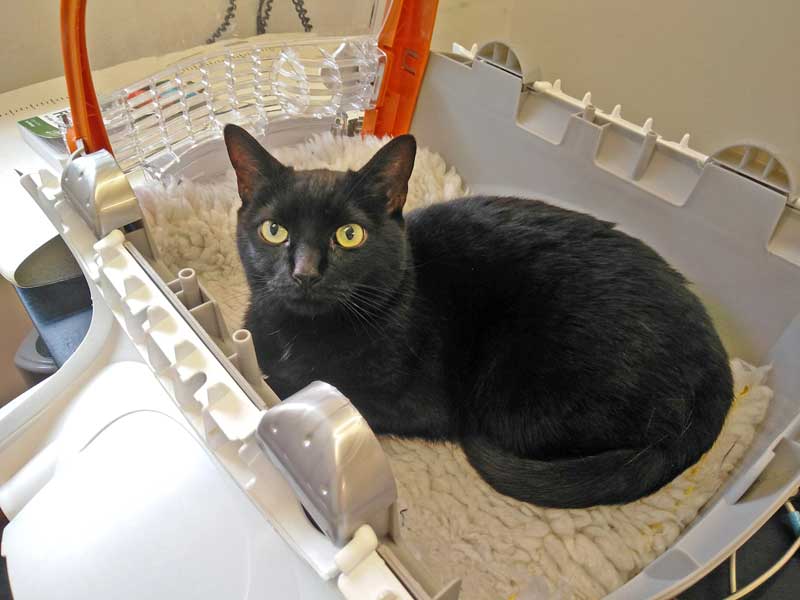
Most cat communication aids cat safety and protects them from interactions with a real or perceived threat (Horwitz and Rodan, 2018). Veterinary professionals can monitor cats for any changes in their body language or behaviour that may indicate they are in a protective emotional state in the consulting room, which signal a different approach may be needed:
Body language. Assess if the cat is staring with wide eyes and dilated pupils, has rapid blinking or eyes shut tightly, has a left gaze bias (associated with the processing of negative stimuli) ears low and/or rotated, is nose licking, has whiskers straight (as opposed to curved in a relaxed cat) and either splayed or pulled back against face, with the muzzle tense and flat. Other signs include tense musculature, trembling, ventral posture, the head and neck pulled in close to the body, a low body carriage, all four paws placed downwards, sweaty paws and a tail clamped tightly around the body or thrashing/thumping (Ellis, 2018; Rodan et al, 2022).
Behaviours. These include hiding, backing away, trying to escape, freezing, hypervigilance, growling, hissing, spitting, swiping, biting, gulping and rapid grooming (Ellis, 2018; Rodan et al, 2022; Figure 12).
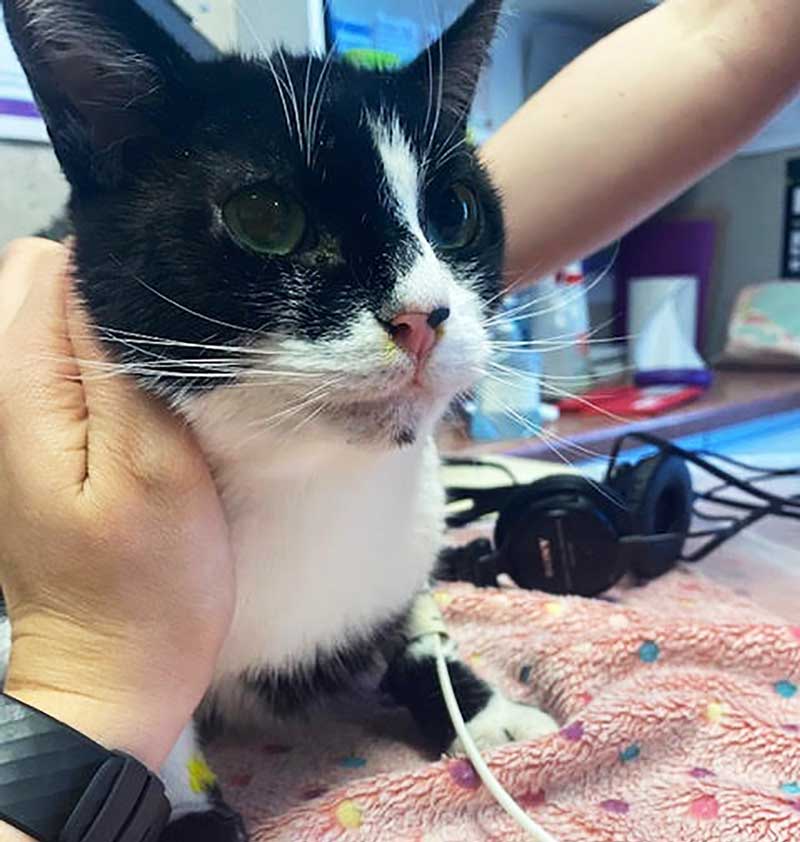
Conversely, cats that are relaxed and confident in the consulting room may sit or even lay in a more relaxed way, with minimal body tension, their head above their shoulders (if sitting), and have ears forward, with curved relaxed whiskers and soft eyes.
In veterinary terms, a cat-friendly interaction is described as “an interaction between a person and a cat that respects the cat as an individual while still achieving the required clinical outcome” (Rodan et al, 2022). Therefore, veterinary professionals should work around the cat during examinations and procedures, adapting any interactions to meet their needs. Cat-friendly interactions include:
- Allowing cats to position themselves however they feel most comfortable and working around them.
- Gathering as much information as possible by just observing the cat at first.
- Consideration of preferred touch points in cats generally and as an individual. Achieve this through asking the caregiver (Figure 13).
- Leaving painful or sensitive areas until the end of the examination.
- Using treats for distraction and to reinforce desired behaviour, where necessary. Treats should be offered passively at first, that is placed, on the exam table/in a bowl, as more anxious cats may not want to take treats directly from the hand.
- Allowing the cat to come out of the carrier in their own time or examining them inside it.
- Avoiding staring into a cat’s face or looming over them.
- Moving slowly and speaking softly throughout.
- Avoiding taking the cat “out the back” for blood samples and procedures – perform these in the consulting room where possible.
- Use of cat-friendly equipment, for example, quiet clippers, small gauge needles or topical local anaesthetic cream.
- Gentle and respectful handling techniques – a “less is more” approach is recommended.
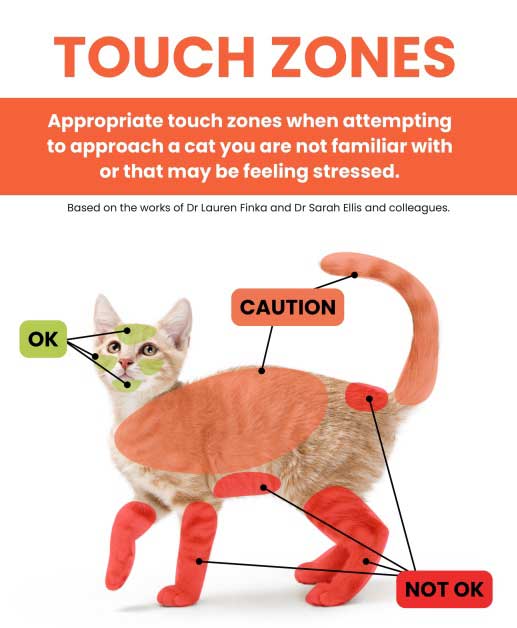
The use of scruffing or full body restraint is not recommended in cats (Moody et al, 2018; 2019). Not only can scruffing trigger further distress in cats already experiencing the feeling of being vulnerable in the veterinary environment, it can also be painful, intensifying any protective emotions the cat is experiencing, affecting behaviour at the next visit and putting staff at risk of injury.
Trouble shooting
Cats need to feel in control of what is happening in their environment, including how people interact with them.
Examinations of cats in a high state of arousal and protective emotional state should not proceed, as serious welfare implications can result from continuing.
Some cats also learn that repulsion behaviours stop interactions and so are more likely to occur again in the future (Ryan, 2018). Instead, veterinary professionals can stop and reassess the situation, discussing the next steps while taking into consideration the cat’s welfare and the priority of any clinical examinations and procedures. Different approaches may be needed, depending on the individual’s temperament and response to interactions with the veterinary team. Using equipment such as a large, thick towel can be highly effective at facilitating easier handling by allowing the cat to hide while each area of the cat is exposed and examined (Figure 14).
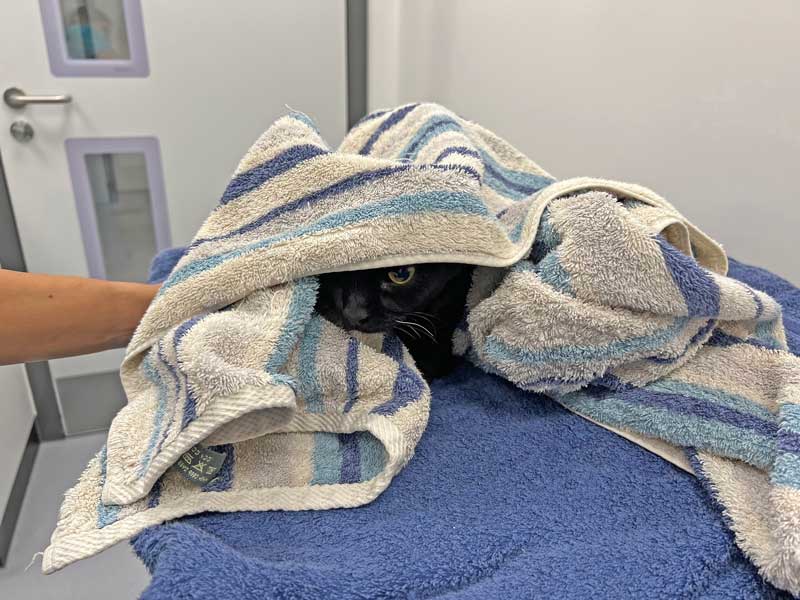
More forceful and restrictive equipment, such as cat bags, muzzles and gauntlets, are no longer recommended for use in cats due to the increased risk of discomfort, and their likelihood of triggering intense protective emotions and associated behavioural responses (Taylor et al, 2022).
Some cats will benefit from taking a short break if procedures such as blood sampling are necessary. Veterinary professionals can also offer solutions, such as the caregiver leaving the clinic and coming back later that day, so the cat has some time to decompress prior to the procedure. However, that strategy may not be applicable to cats in an extremely high state of arousal.
Vets can delegate many additional procedures to the veterinary nursing team; therefore, utilising skills and freeing the vet up to continue consulting.
Some cats are also more relaxed for procedures in the consulting room when their caregiver is present. However, in some cases, rescheduling the cat’s appointment to a different day, with some sedation on board, is kinder for the cat and safer for the veterinary team.
Sedation/anxiolytics
Although sedation does not change a cat’s perception of their environment and any interactions with the veterinary team, it can alter their capability to respond to stressors at the clinic; therefore, preventing behaviours that could make examinations challenging (Taylor et al, 2022). However, while sedating cats already in a high state of arousal may seem like a viable option, it does not come without its own risks and disadvantages.
An increased release of catecholamines in these cats can cause tachycardia, tachypnoea and hypertension, which can increase the risks associated with sedation or anaesthesia (Robertson et al, 2018). The effects of sedation can also be less reliable in highly aroused cats, meaning higher doses are needed to achieve the desired outcome, putting additional stress on the cat’s cardiovascular and respiratory system (Grubb et al, 2020) and at a higher financial cost to the caregiver.
Administering sedation to cats showing repulsion behaviours, such as swiping and biting, can also be dangerous to the veterinary team. Instead, a discussion can be had with caregivers about the benefits of rescheduling the appointment for another day, so the cat has already been administered anxiolytics at home prior to the veterinary visit. This means cats arrive at the clinic much calmer, ensuring any necessary examinations and procedures are carried out with minimal stress to the cat and while maintaining safety of the veterinary team (van Haaften et al, 2017).
Oral anxiolytics, such as gabapentin and trazadone, can be prescribed by vets as pre-visit anxiolytics. Pregabalin may become more widely available for use as a pre-visit anxiolytic in cats in the future (Gonzalez et al, 2025). A liquid medication containing pregabalin is now available.
Common adverse effects of these medications include sedation and ataxia, and effects may be dose dependent and can vary between individuals (van Haaften et al, 2017; Figure 15).

The use of pre-visit anxiolytics over the past few years has become more popular. These medications are an effective tool that helps veterinary teams to provide veterinary care to cats that are usually too distressed to allow any interactions. However, it is important to remember that they do not replace preparing a cat-friendly environment or cat-friendly interactions.
Conclusion
Cats are highly sensitive, sensory beings, and as such they can find veterinary appointments overwhelming and anxiety inducing.
However, veterinary professionals can put cat-friendly measures in place before and during the veterinary consultation to minimise exposure to stressors in cats and any distress they might cause.
Thinking ahead (and sometimes outside of the box) and going slow may seem counterintuitive in a bustling and sometimes high-pressure clinic environment, but embracing this cat-friendly approach will enable more successful veterinary care in cats.
To phrase the Navy SEALs: “Slow is smooth and smooth is fast”. (Morris, 2023).
- This article appeared in Vet Times (2025), Volume 55, Issue 18, Pages 14-18 and VN Times (April 2025), Volume 25, Issue 4, Pages 4-8.
References
- Caney SM et al (2022). Happy cats: stress in cats and their carers associated with outpatient visits to the clinic, J Feline Med Surg 24(12): e551-e557.
- Ellis SLH et al (2013). AAFP and ISFM Feline environmental needs guidelines, J Feline Med Surg 15(3): 219-230.
- Ellis SLH (2018). Recognising and assessing feline emotions during the consultation: history, body language and behaviour, J Feline Med Surg 20(5): 445-456.
- Furgala NM et al (2022). Veterinary background noise elicits fear responses in cats while freely moving in a confined space and during an examination, Behav Processes 201: 104712.
- Gonzalez SE et al (2025). What’s new with feline-friendly previsit pharmaceuticals, tinyurl.com/3cfsj9ts
- Grubb T et al (2020). 2020 AAHA anesthesia and monitoring guidelines for dogs and cats, J Am Anim Hosp Assoc 56(2): 59-82.
- Horwitz DF and Rodan I (2018). Behavioral awareness in the feline consultation: Understanding physical and emotional health, J Feline Med Surg 20(5): 423-436.
- Mills D (2016). What are stress and distress, and what emotions are involved? In Sparkes A and Ellis S (eds), ISFM Guide to Feline Stress and Health: Managing Negative Emotions to Improve Feline Health and Wellbeing, ISFM, Tisbury: 7-18.
- Moody CM et al (2018). Can you handle it? Validating negative responses to restraint in cats, Appl Anim Behav Sci 204: 94-100.
- Moody CM et al (2019). Getting a grip: cats respond negatively to scruffing and clips, Veterinary Record 186(12): 385.
- Morris G (2023). “Slow is smooth. Smooth is fast”, George Morris – Medium, tinyurl.com/6f5cbbus
- Pereira JS et al (2015). Improving the feline veterinary consultation: the usefulness of Feliway spray in reducing cats’ stress, J Feline Med and Surg 18(12): 959-964.
- Robertson SA et al (2018). AAFP Feline anesthesia guidelines, J Feline Med Surg 20(7): 602-634.
- Rodan I et al (2022). 2022 AAFP/ISFM cat friendly veterinary interaction guidelines: approach and handling techniques, J Feline Med Surg 24(11): 1,093-1,132.
- Ryan L (2018). Better veterinary visits – working towards a patient-friendly practice, Vet Nursing J 33(6): 171-174.
- Taylor S et al (2022). 2022 ISFM/AAFP cat friendly veterinary environment guidelines, J Feline Med Surg 24(11): 1,133-1,163.
- Van Haaften KA et al (2017). Effects of a single preappointment dose of gabapentin on signs of stress in cats during transportation and veterinary examination, J Am Vet Med Assoc 251(10): 1,175-1,181.
